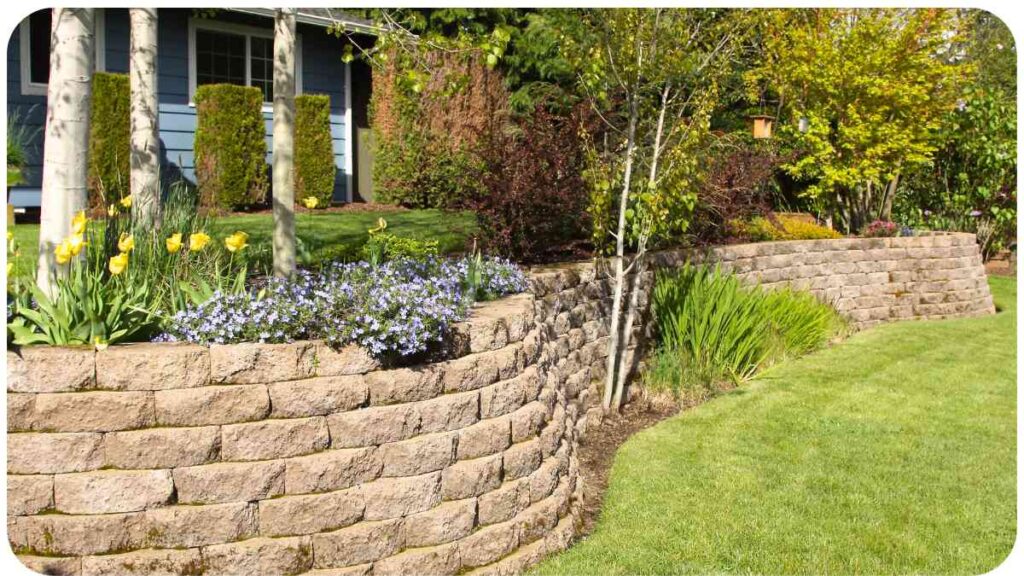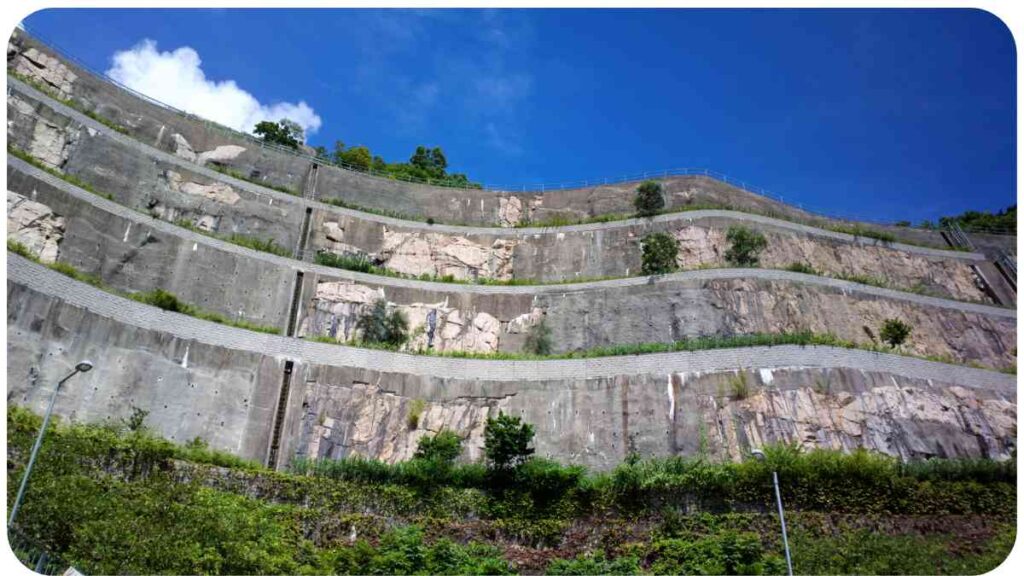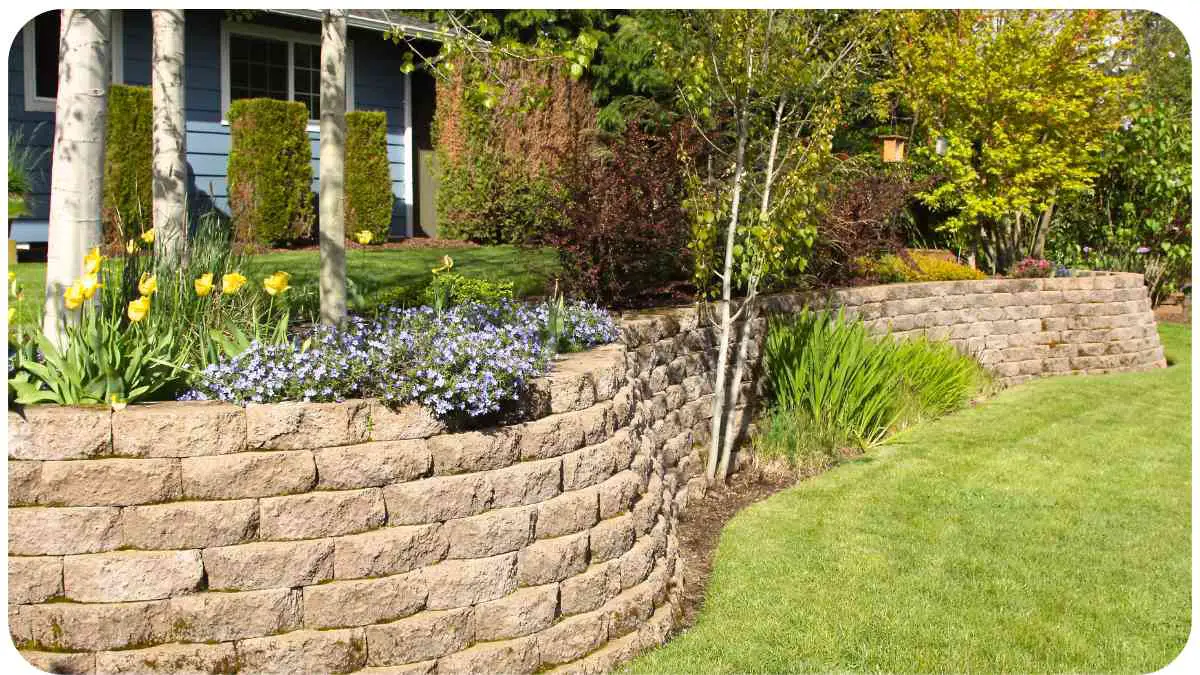Welcome to a comprehensive guide on retaining wall failures and how to address them effectively. Retaining walls play a crucial role in landscaping, but they are susceptible to various issues that can lead to failure if not properly managed.
In this article, we’ll delve into the common causes of these failures, signs to watch for, and practical solutions to fix them. Whether you’re a DIY enthusiast or considering professional help, you’ll find valuable insights here.
| Takeaways |
|---|
| Understand common causes of retaining wall failures |
| Recognize the signs of retaining wall problems |
| Learn how to assess and address minor issues |
| Know when to hire professionals for major repairs |
| Discover preventive measures for long-term stability |
| Realize the consequences of neglecting maintenance |
| Explore additional resources for further reading |
Understanding Retaining Walls
What Are Retaining Walls?
Retaining walls are structures designed to hold back soil, preventing erosion and creating level spaces in sloped areas. They are not only functional but can also enhance the aesthetics of your property.
Discover the essentials of hardscaping with our Ultimate Guide to Hardscaping. Explore expert tips, trends, and common mistakes to create stunning outdoor spaces that stand the test of time.
Types of Retaining Walls

There are several types of retaining walls, including gravity walls, cantilever walls, and anchored walls. Each has its own advantages and is suitable for different scenarios.
Table 1: Types of Retaining Walls
| Type | Description | Suitable Conditions |
| Gravity Walls | Use their weight to resist soil pressure | Low to Medium Heights |
| Cantilever Walls | Utilize leverage for stability | Medium Heights |
| Anchored Walls | Incorporate anchors for added support | High or Challenging Sites |
Common Causes of Retaining Wall Failures
Retaining wall failures can be attributed to several factors. Understanding these root causes is essential for effective repairs and prevention.
Stay ahead of the curve with insights into the Top Hardscaping Trends for 2023. Learn about innovative designs and features that are reshaping outdoor living, making your space both stylish and functional.
Poor Drainage
Table 2: Effects of Poor Drainage
| Issue | Consequences |
| Water Buildup | Excess water pressure against the wall |
| Soil Saturation | Reduced soil stability |
| Frost Heaving | Freezing water expands and damages walls |
| Corrosion of Materials | Accelerated deterioration of materials |
Improper Material Selection
Table 3: Materials for Retaining Walls
| Material | Pros | Cons |
| Concrete | Durable and versatile | Expensive and can crack over time |
| Timber | Natural look, easy to work with | Prone to rot and termite infestations |
| Gabion Baskets | Excellent drainage, eco-friendly | Limited design options |
| Segmental Blocks | Variety of designs, easy to install | May require periodic resetting |
Design Flaws
Table 4: Common Design Flaws
| Flaw | Impact |
| Inadequate Reinforcement | Wall may not withstand soil pressure |
| Incorrect Slope | Poor drainage and stability issues |
| Overloading | Excessive weight leading to collapse |
| Lack of Weep Holes | Trapped water causing damage |
Construction Errors
Table 5: Common Construction Errors
| Error | Consequences |
| Poor Foundation | Reduced stability and increased leaning |
| Inadequate Compaction | Settling and soil displacement |
| Insufficient Backfilling | Pressure on the wall, leading to bulging |
| Improper Drainage System | Water buildup and erosion underneath the wall |
Lack of Maintenance
Table 6: Effects of Neglected Maintenance
Avoid pitfalls in your hardscape projects by recognizing Common Hardscaping Mistakes. Our guide highlights errors to steer clear of, ensuring your outdoor projects achieve lasting beauty and functionality.
| Neglected Maintenance Activity | Consequences |
| Weeding and Cleaning | Weeds can destabilize the wall |
| Drainage Clearing | Water accumulation and pressure issues |
| Soil Re-grading | Soil erosion and instability |
| Inspections | Undetected issues leading to failures |
Signs of Retaining Wall Failures

Identifying the early warning signs of retaining wall failures is crucial for timely intervention. Here are some key indicators to watch out for:
Tilting or Leaning
Table 7: Signs of Tilting or Leaning
| Indication | Severity |
| Slight Incline | Early Stage of Failure |
| Noticeable Tilt | Moderate Risk |
| Significant Lean | Immediate Attention Needed |
Cracking
Table 8: Types of Wall Cracks
| Crack Type | Implications |
| Hairline Cracks | Minor Surface Issue |
| Horizontal Cracks | Soil Pressure or Poor Design |
| Vertical Cracks | Foundation or Drainage Problem |
| Stair-Stepped Cracks | Structural Failure |
Bulging
Table 9: Bulging Characteristics
| Bulging Type | Causes |
| Outward Bulging | Soil pressure or inadequate backfilling |
| Inward Bulging | Drainage issues or soil erosion |
| Lateral Movement | Foundation problems or poor construction |
Water Damage
Table 10: Effects of Water Damage
Embark on a transformative journey with our Ultimate Guide to Landscape Renovation. From planning to execution, gain insights into creating a refreshed outdoor space that reflects your style and enhances your lifestyle.
| Damage Type | Impact |
| Discoloration | Surface aesthetics compromised |
| Crumbling or Erosion | Structural integrity compromised |
| Mold and Mildew | Health hazards and further structural damage |
Soil Erosion
Table 11: Soil Erosion and Consequences
| Erosion Level | Effects |
| Minor Erosion | Reduced support for the retaining wall |
| Moderate Erosion | Heightened risk of collapse |
| Severe Erosion | Imminent failure, immediate attention |
Assessing the Damage
When you notice any of these signs, it’s essential to assess the extent of the damage. Begin by documenting the issues and consulting with a professional if necessary. Understanding the severity will help you determine the appropriate course of action.
Illuminate your outdoor oasis with 17 Creative Ideas for Landscape Lighting. From subtle accents to dramatic focal points, discover innovative ways to incorporate lighting that enhances your landscaping, creating a mesmerizing atmosphere for your outdoor living.
DIY Fixes for Minor Issues
For minor retaining wall issues, you can often address them yourself with some basic tools and materials. Here are some common DIY fixes:
Repairing Small Cracks
Table 12: Steps for Repairing Small Cracks
| Step | Description |
| Clean the Crack | Remove debris and loose material from the crack |
| Fill the Crack | Use an appropriate filler or epoxy |
| Smooth the Surface | Ensure an even finish |
| Paint or Seal | Protect the repaired area from further damage |
Reinforcing with Geogrid
Table 13: Steps for Reinforcing with Geogrid
| Step | Description |
| Excavation | Dig a trench behind the wall |
| Install Geogrid | Lay geogrid material in layers |
| Backfilling | Carefully compact the soil as you fill in the trench |
| Wall Reconstruction | Rebuild the wall structure |
Adding Drainage
Table 14: Steps for Adding Drainage
| Step | Description |
| Excavate | Dig a trench at the base of the wall |
| Lay Drainage Pipe | Install a perforated pipe for water diversion |
| Backfill with Gravel | Provide drainage path for water |
| Cover with Filter Fabric | Prevent clogging of the pipe |
Replanting and Landscaping
Table 15: Landscaping Tips
| Tip | Impact |
| Plant Deep-Rooted Plants | Enhance soil stability and drainage |
| Mulch Regularly | Maintain soil moisture and temperature |
| Control Erosion | Prevent further soil loss |
| Strategic Design | Distribute pressure on the wall evenly |
Remember that these DIY fixes are suitable for minor issues. For more extensive damage, it’s advisable to consult a professional.
Hiring a Professional for Major Repairs
When your retaining wall experiences significant damage or structural issues, it’s best to leave the repairs to professionals. They have the expertise and equipment to handle complex situations. Here are some major repair options:
Foundation Reinforcement
Table 16: Foundation Reinforcement Methods
| Method | Description |
| Helical Piers | Screw-like supports to stabilize the foundation |
| Soldier Piles and Lagging | Steel piles and wooden lagging for reinforcement |
| Concrete Underpinning | Additional concrete support for the foundation |
Full Wall Replacement
Table 17: Steps for Full Wall Replacement
| Step | Description |
| Demolition | Remove the existing wall |
| Foundation Work | Ensure a stable base |
| New Wall Build | Construct a new retaining wall |
| Backfilling | Carefully compact the soil |
| Landscaping | Restore the area’s appearance |
Drainage System Installation
Table 18: Benefits of Professional Drainage Installation
| Benefit | Impact |
| Expert Design | Customized drainage solutions |
| Quality Materials | Durable and long-lasting systems |
| Proper Installation | Efficient water diversion and erosion prevention |
| Maintenance Guidance | Tips for keeping the system in optimal condition |
Proper Soil Compaction
Table 19: Importance of Soil Compaction
| Aspect | Influence |
| Stability of the Wall | Prevents settling and shifting |
| Drainage Efficiency | Ensures proper water flow |
| Longevity of the Wall | Reduces the risk of future damage |
| Cost-Effective Maintenance | Minimizes the need for frequent repairs |
When considering professional help, be sure to research and select a reputable contractor with experience in retaining wall repair.
Preventing Retaining Wall Failures
Preventing issues before they occur is the best approach when it comes to retaining walls. Here are some proactive steps to keep your wall in good condition:
Regular Inspections
Table 20: Inspection Checklist
| Inspection Area | Key Points to Check |
| Wall Structure | Cracks, bulging, leaning |
| Drainage System | Clogs, damage, functionality |
| Soil Stability | Signs of erosion or settling |
| Vegetation | Weeds or plants affecting stability |
Proper Drainage Planning
Table 21: Drainage Strategies
| Strategy | Impact |
| Slope Analysis | Ensure proper grading and runoff |
| French Drains | Divert water away from the wall |
| Weep Holes | Allow water to escape from behind the wall |
| Gravel Backfill | Enhance drainage within the soil |
Material Selection
Table 22: Material Considerations
| Aspect | Influence |
| Soil Type | Match material to soil conditions |
| Wall Height | Choose materials suitable for the height |
| Aesthetics | Balance function and appearance |
| Climate | Consider material durability in your region |
Professional Installation
Table 23: Advantages of Professional Installation
| Advantage | Impact |
| Expertise | Proper design and construction |
| Efficiency | Timely completion and cost savings |
| Warranties | Quality assurance and peace of mind |
| Compliance | Adherence to local building codes |
Landscaping Maintenance
Table 24: Landscaping Maintenance Tips
| Tip | Impact |
| Regular Weeding and Cleaning | Prevent weed pressure on the wall |
| Mulching | Retain moisture and regulate temperature |
| Erosion Control | Protect the wall from soil loss |
| Pruning and Trimming | Prevent vegetation interference |
By following these preventative measures, you can significantly extend the life of your retaining wall and reduce the likelihood of costly repairs.
Real-Life Stories: Dealing with Retaining Wall Failures
Sometimes, real stories from individuals who have faced retaining wall challenges can provide valuable lessons. Here are two such stories:
John’s DIY Disaster
John, an enthusiastic DIYer, decided to build his own retaining wall to save on costs. He chose timber as the material for its rustic appeal. However, he underestimated the importance of proper drainage. After a heavy rainfall, the wall started to lean dangerously. John had to enlist professional help to fix his DIY disaster.
Table 25: Lessons from John’s Experience
| Lesson | Takeaway |
| Importance of Drainage | Proper drainage is non-negotiable |
| Professional Consultation | Sometimes DIY isn’t the best choice |
| Material Compatibility | Choose materials suitable for your project |
Sarah’s Successful Repair
Sarah’s retaining wall faced severe cracking due to soil pressure and poor drainage. Recognizing the issue early, she sought the advice of a professional contractor. They repaired the wall, improved drainage, and reinforced the foundation. Sarah’s retaining wall now stands strong and serves as a testament to the value of timely action.
Table 26: Lessons from Sarah’s Experience
| Lesson | Takeaway |
| Timely Professional Intervention | Addressing issues promptly prevents escalation |
| Comprehensive Repairs | Fixing underlying problems ensures long-term stability |
| Regular Maintenance and Inspections | Preventive measures are key to retaining wall health |
Expert Tips for Retaining Wall Maintenance
To maintain your retaining wall’s integrity, consider these expert tips:
Seasonal Checks
Table 27: Seasonal Maintenance Checklist
| Season | Maintenance Tasks |
| Spring | Check for winter damage and clean |
| Summer | Inspect for cracks and erosion |
| Fall | Remove leaves and debris |
| Winter | Monitor for ice and snow buildup |
Weeding and Cleaning
Table 28: Weeding and Cleaning Tips
| Tip | Impact |
| Regular Weeding | Prevent weed growth that can damage the wall |
| Pressure Washing | Remove dirt and stains |
| Algae and Mold Prevention | Maintain wall aesthetics |
Re-grading
Table 29: Steps for Re-grading
| Step | Description |
| Survey the Area | Assess slope and drainage issues |
| Remove Excess Soil | Correct the grading as needed |
| Compact the Soil | Ensure stable soil compaction |
| Reinforce with Erosion Control Measures | Prevent further erosion |
Professional Inspections
Table 30: Benefits of Professional Inspections
| Benefit | Impact |
| Early Issue Detection | Address problems before they worsen |
| Structural Integrity Check | Ensure safety and compliance |
| Expert Recommendations | Receive guidance on needed repairs |
| Longevity Assurance | Extend the life of your retaining wall |
By following these expert tips, you can ensure your retaining wall remains sturdy and attractive for years to come.
The Cost of Neglect
Neglecting your retaining wall can have significant consequences, both in terms of safety and finances. Here’s a closer look at the costs associated with neglect:
Structural Damage
Table 31: Costs of Structural Damage
| Damage Severity | Repair Costs | Additional Expenses |
| Minor | Lower cost | Minimal landscaping |
| Moderate | Moderate cost | Some property disruption |
| Severe | High cost | Extensive landscaping |
Legal Liabilities
Table 32: Legal Consequences
| Neglect Effect | Potential Liabilities |
| Wall Collapse | Property damage, injury, and legal actions |
| Code Violations | Fines and mandatory repairs |
| Environmental Impact | Penalties for soil erosion and water runoff |
Property Value
Table 33: Impact on Property Value
| Neglect Effect | Impact on Property Value |
| Well-Maintained | Positive or stable property value |
| Neglected | Decreased property value |
| Unsafe Conditions | Potential buyer reluctance and price reduction |
Conclusion
In conclusion, retaining wall failures are common but preventable issues. Understanding the causes, signs, and repair options can help you maintain the integrity of your wall. Whether you choose to tackle minor repairs yourself or seek professional assistance, timely action is key.
Remember to conduct regular inspections, implement proper drainage, and select suitable materials for your project. Real-life stories illustrate the importance of proactive measures, while expert tips offer guidance on effective maintenance.
Neglecting your retaining wall can result in structural damage, legal liabilities, and reduced property value. By taking a proactive approach to maintenance and addressing issues promptly, you can ensure that your retaining wall remains both functional and aesthetically pleasing for years to come.
By following the advice and information provided in this article, you’ll be well-equipped to handle retaining wall challenges and maintain a safe and beautiful landscape.
Further Reading
Here are some additional resources to explore for more in-depth information on retaining wall problems and solutions:
- Retaining Wall Problems and Solutions: This comprehensive article offers insights into common retaining wall issues and effective solutions for resolving them.
- Retaining Wall Failure 101 and How to Fix the Issues: Learn about the fundamentals of retaining wall failures and discover practical strategies for addressing these issues.
- 7 Reasons Retaining Walls Fail: 7 Steps to Repairing Them and More: This resource delves into the seven common reasons behind retaining wall failures and provides a step-by-step guide to repairs and more.
FAQs
What are the typical signs of retaining wall failure?
- Answer: Signs of retaining wall failure can include tilting, cracking, bulging, water damage, and soil erosion.
Is it possible to repair minor retaining wall issues on my own?
- Answer: Yes, minor issues like small cracks or weeding can often be repaired as DIY projects. However, for major problems, it’s advisable to consult professionals.
What steps can I take to prevent retaining wall failures?
- Answer: To prevent failures, conduct regular inspections, ensure proper drainage, choose suitable materials, opt for professional installation, and maintain your landscaping.
How can I assess the severity of retaining wall damage?
- Answer: Assess the damage by documenting the issues, consulting with a professional, and understanding the extent of the problem. This will help you determine the appropriate course of action.
What are the potential costs and liabilities associated with neglecting retaining wall maintenance?
- Answer: Neglecting retaining wall maintenance can lead to significant costs, including expenses for repairs, legal liabilities in case of accidents, and decreased property value due to unsafe conditions.

Hi! My name is Hellen James, and I’m a landscape designer in Los Angeles. I’ve been working with homeowners and businesses to help them improve the look of their properties for over 10 years.


